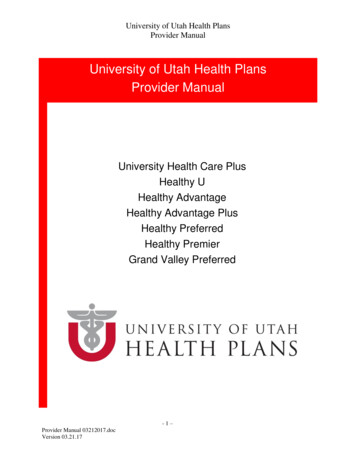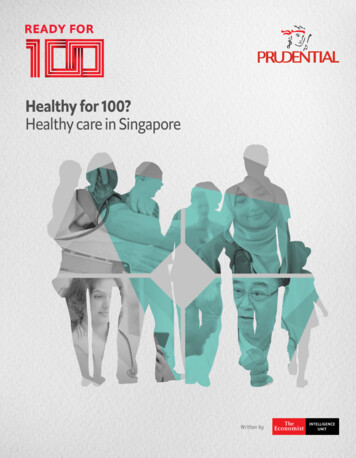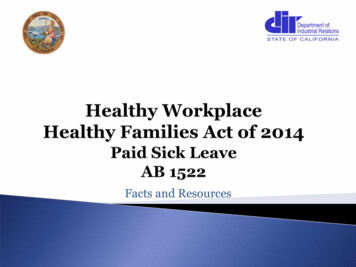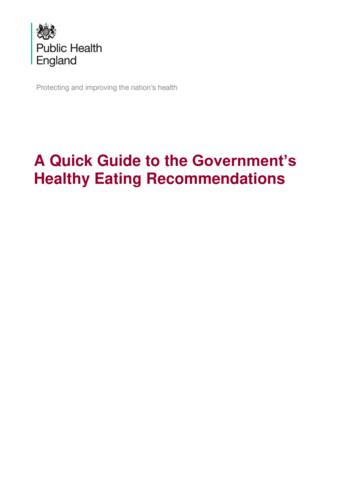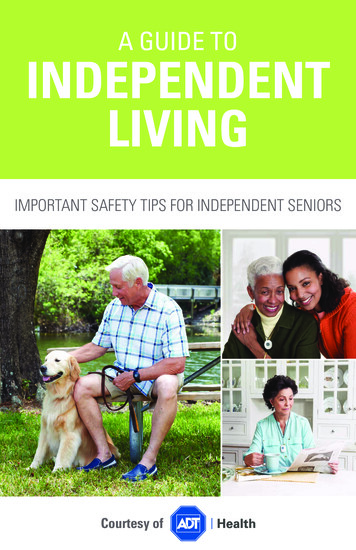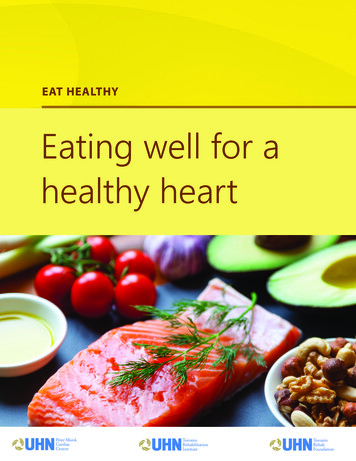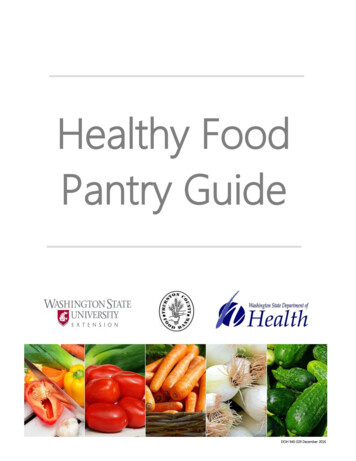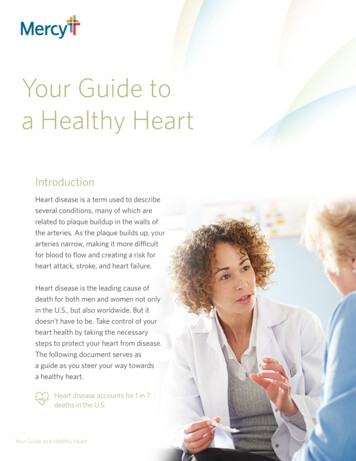
Transcription
Your Guide toa Healthy HeartIntroductionHeart disease is a term used to describeseveral conditions, many of which arerelated to plaque buildup in the walls ofthe arteries. As the plaque builds up, yourarteries narrow, making it more difficultfor blood to flow and creating a risk forheart attack, stroke, and heart failure.Heart disease is the leading cause ofdeath for both men and women not onlyin the U.S., but also worldwide. But itdoesn’t have to be. Take control of yourheart health by taking the necessarysteps to protect your heart from disease.The following document serves asa guide as you steer your way towardsa healthy heart.Heart disease accounts for 1 in 7deaths in the U.S.Your Guide to a Healthy Heart 1
Section 1: Recognizing and Treating Heart DiseaseHeart disease isn’t just one disease, but rather a number of conditions that affect the heart’sability to function normally. Some of the conditions are: Coronary artery disease Heart valve disease Heart attack Congenital heart disease Abnormal heart rhythms or arrhythmias Heart muscle disease orcardiomyopathy Heart failure Vascular or blood vessel diseaseSymptoms of heart disease vary depending on the specific condition. Always seek emergencymedical care if you ever experience chest pain, shortness of breath or fainting.The goals of treatment for heart disease are to relieve symptoms, reduce additional risk factorsto slow the buildup of plaque, widen coronary arteries, and prevent complications. Treatmentcan include lifestyle changes, medicines, surgical procedures, and cardiac rehabilitation.Section 2: Identifying Risk FactorsRisk factors are things that increase your chances for developing heart disease. The mostimportant thing you can do to improve heart health is to identify your own heart disease riskand learn the steps you can take to control that risk. While there are some risk factors you can’tcontrol (family history, age, gender), there are factors you can control. These items include: Smoking. Smoking is the most preventable cause ofdisease and death in the United States. Accordingto research, your lungs begin to heal themselves assoon as you stop smoking.Will smoking increase myrisk for heart attack? High blood pressure. Blood pressure is a measure of how hard the blood pushesagainst the walls of your arteries as it moves through your body. When blood pressureis high, it starts to damage the blood vessels, heart, and kidneys.Your Guide to a Healthy Heart 2
High cholesterol. Cholesterol is a type of fat in your blood. If you have too much,it can build up in your arteries and increase your risk of heart disease and stroke. Diabetes. Diabetes is a condition that affects how insulin is produced and used inthe body. Over time, this condition can speed up the hardening and narrowing of thecoronary arteries. Being overweight. There is a direct correlation between being overweight and beingat risk for heart disease. Being overweight also increases other risk factors, such ashigh blood pressure, diabetes, and high cholesterol. Lack of exercise. If you are inactive, you have a higher risk of heart disease. Being activehelps keep your heart and blood vessels healthy and working properly. Stress. Your stress level can be bad for your heart. It can raise your blood pressure andyour heart rate, making your heart work harder and increasing your risk for heart attack. Metabolic syndrome. Metabolic syndrome is a combination of metabolic disorders thatraise the risk for heart disease. Risk factors include too much fat around the waist, highblood pressure, elevated blood sugar, high cholesterol, and high levels of triglycerides. Sleep apnea. Sleep apnea is a disorder in which a person briefly stops breathing duringsleep. Left untreated, people with sleep apnea are more likely to develop high bloodpressure, heart attack, congestive heart failure, and stroke.Screenings to Control Your Heart HealthHeart screenings can help you successfully manage your heart health. To determinewhether you are at risk for a heart problem, you should be aware of five key numbers: total cholesterol HDL (good) cholesterol blood pressure blood sugar body mass index (BMI)Your Guide to a Healthy Heart 3
Blood pressure – Blood pressure readings consist of an upper number (systolic) and alower number (diastolic). High blood pressure (140/90 or higher) can lead to heart attack,stroke, and other problems.About 80 million U.S. adults have high blood pressure.Cholesterol – Knowing your total cholesterol and HDL (good) cholesterol can give you ageneral idea about your cholesterol levels. If your total cholesterol is 200 mg/dL or more,or if your HDL is less than 40 mg/dL, you will need to have a more extensive lipoproteinprofile done.About 43% of Americans have total cholesterol higher of 200 mg/dL or higher.Blood Sugar – A blood glucose test measures the amount of sugar in your blood. Highblood sugar can damage the walls of your arteries, leading to a narrowing or blockage ofyour arteries.Diabetes rates are growing; about 35% of Americans have pre-diabetes.Body mass index – Your BMI is a measure of body fat based on height and weight;the higher your BMI, the higher your risk for heart disease. To calculate your BMI:1. Multiply your weight in pounds by 703.2. Multiply your height in inches by itself (i.e. inches squared).3. Divide the number from step 1 by the number in step 2.ConditionNormalHighHigh Blood Pressure120 systolic / 80 diastolic140 systolic / 90 diastolicTotal CholesterolLess than 200mg/dL240 mg/dL and aboveLDL CholesterolLess than 100 mg/dL160 mg/dL and aboveHDL Cholesterol60 mg/dL and aboveLess than 40 mg/dLTriglyceridesLess than 150 mg/dL200 mg/dL and aboveBlood GlucoseUnder 99 mg/dL126 mg/dL and aboveBody Mass Index (BMI)18.5 – 24.930 or greaterRoughly 69% of U.S. adults are overweight or obese.Your Guide to a Healthy Heart 4
Other Heart TestsThere are additional heart tests available that will help your doctor decide if you’re at riskfor a heart problem. Most are noninvasive and can help doctors determine what’s causingyour symptoms. Talk with your doctor to decide if a test is right for you.Questions to Ask Your DoctorYour doctor may talk with you about your risk for heartAm I at risk for aand blood flow problems, including heart attack andheart attack?stroke. You and your doctor can then decide whether youneed to lower your risk and what treatment is best for you. Getting answers to the followingquestions will give you information about your heart health and what you can do to improveit. Bring these questions with you on your next visit to your doctor’s office.1. Am I at risk for heart disease?2. What is my blood pressure reading and what do I need to do about it?3. What do my cholesterol numbers mean for me and what should I do about them?4. What is my body mass index (BMI)? Do I need to lose weight for my health?5. Does my blood sugar level mean I’m at risk for diabetes?6. What other heart disease screenings do I need?7. How often should I return for checkups for my heart health?8. What are the warning signs of heart disease and stroke?9. How can I tell if I’m having a heart attack?10. (If you smoke) What can you do to help me quit smoking?11. How much physical activity do I need to help protect my heart?What kinds of activities are helpful?12. What is a heart healthy eating plan for me? Should I see a registereddietitian or qualified nutritionist to learn more about healthy eating?Your Guide to a Healthy Heart 5
Section 3: Managing Heart HealthIntroducing and maintaining a heart healthy lifestyle is key to lowering your heart diseaserisk. There are several things you can do to avoid or lower your risk for heart disease, heartattack and stroke. These include following a diet low in saturated fat and eating plenty of fruits,vegetables, legumes, and heart-healthy fats; managing stress; and engaging in regular exercise.Create a Heart-Healthy LifestyleIf you are worried about heart disease, one of the most important things you can do is tomaintain a healthy weight and begin eating a heart-healthy diet. Changing your diet canhelp stop or even reverse heart disease. A heart-healthy diet includes: Eating fruits and vegetables. Eat avariety of fruit and vegetable servingsevery day. Dark green, deep orange,and yellow fruits and vegetables areespecially nutritious. Examples includespinach, carrots, peaches, and berries. Eating a variety of grain products everyday. Include whole-grain foods that havea lot of fiber and nutrients. Examples ofwhole grains include oats, whole wheatbread, and brown rice. Limiting saturated fat and cholesterol.To limit saturated fat and cholesterol, tryto choose the following foods: Lean meats and meat alternatives, such as beans or tofu Fish, vegetables, beans, and nuts Nonfat and low-fat dairy products Limiting the amount of trans fat you eat. Trans fat raises the levels of LDL (bad)cholesterol and also lowers HDL (good) cholesterol in the blood. Trans fat is foundin many processed foods made with shortening or with partially hydrogenatedor hydrogenated vegetable oils. These foods include cookies, crackers, chips, andmany snack foods.Your Guide to a Healthy Heart 6
You don’t have to giveup your favorite recipesin order to be healthy.Simple substitutions canmake all the differencefor a heart-healthy lifestyle. Choosing healthy fats. Unsaturated fats, such as olive, canola, corn, and sunflower oils,are part of a healthy diet. But all fats are high in calories, so watch your serving sizes. Limiting sodium. For good health, less is best. This is especially important for people whoare at risk for, or already have, high blood pressure. Try to limit sodium to 2,300 mg a day.If you are African-American, have diabetes or chronic kidney disease, or are older thanage 50, try to limit the amount of salt you eat to less than 1,500 mg a day. Eating only as many calories as you need to stay at a healthy weight. Learn how muchis considered a serving, and then check your portion sizes. If you want to lose weight,increase your activity level to burn more calories than you eat. Drinking alcohol in moderation. If you drink, limit alcohol intake to 2 drinks a day formen and 1 drink a day for women.Your Guide to a Healthy Heart 7
Quit SmokingQuitting smoking is hard, but you can do it. The good news is that you don’t have todo it alone. Ask your family, friends, and doctor to help you. Some ways to help you onyour smoke-free journey include: Preparation. If you like to plan ahead, set a date to quit. Pick a time when you won’thave a lot of stress in your life. Talk to your partner and friends about helping you staysmoke-free. Don’t let people smoke in your house. A change in routine. For example, if you smoke after eating, take a walk instead. Medication. Medicine can help with cravings and stress, and can increase your chancesfor success. You can buy nicotine gum, lozenges, or patches without a prescription. Yourdoctor may also prescribe medicine. Support. Seek help from: Mercy’s Road to Freedom tobacco cessation program The National Network of Tobacco Cessation quitline: 1-800-QUIT NOW(1-800-784-8669). Free smartphone, tablet, or handheld computer apps, such as the NationalCancer Institute’s QuitPal. Internet programs, such as www.smokefree.gov, which also have chat rooms. Doctors, nurses, or therapists for counseling. A friend who has quit smoking.Take this quiz to learn howsmoking affects your chanceof having a heart attack inthe next 10 years.Your Guide to a Healthy Heart 8
Stay ActiveStaying active can improve your health. It is good for your heart, lungs, bones, muscles, andjoints; it also lowers your risk for falls, heart attack, diabetes, high blood pressure, and somecancers. If you already have one or more of these problems, getting fit may help you controlother health problems and make you feel better.Moderate physical activity is safe for most people. But it’s always a good idea to talk to your doctorbefore becoming more active, especially if you haven’t been very active or have health problems.If you’re ready to add more physical activity to your life, here are some tips to get you started: Make physical activity part of your regular day. Make a regular habit of using stairs,not elevators, and walking to do errands near your home. Start walking. Walking is a great fitness activity that most people can start rightaway. Take a daily walk with family members, friends, coworkers, or pets. Find an activity partner. This can make exercising more fun and hold you accountable. Find an activity that you enjoy, and stick with it. Vary it with other activities so youdon’t get bored.It doesn’t take much to become active. Experts say to do either of these things to getand stay healthy: Do some sort of moderate aerobic activity, like brisk walking, for at least 2½ hourseach week. It is best to be active at least 3 days a week, for at least 10 minutes ata time. For example, you could: Take a 10-minute walk 3 times a day. Do this 5 days a week. Take a half-hour walk 3 days a week. On the other 4 days, take a 15-minute walk. Take a 45-minute walk every other day. Do more vigorous activities, like running, for at least 1¼ hours a week. This activitymakes you breathe harder and have a much faster heartbeat than when you are resting.It is better to be active at least 3 days a week for at least 10 minutes at a time. Forexample, you could: Run for 25 minutes 3 times a week. Run for 15 minutes 5 times a week.Your Guide to a Healthy Heart 9
imageFind out how many caloriesyou burn during exercisewith our interactive tool.Your Guide to a Healthy Heart 10
Section 4: Choosing the Right Heart & VascularCenter Could Save Your Life!At Mercy, our cardiac care program offers comprehensive services, a wide variety oftreatment options, and advanced technologies to diagnose and treat heart disease.We provide the highest quality of patient care and work with you and your primary caredoctor at every stage of the process. Mercy’s Heart and Vascular team of speciallytrained cardiologists, technologists, and nurses will provide you with the very bestheart care, so you can do more of what you love.Mercy is proud to be ranked as one of the top five large health systems in the nation,according to the 2016 Truven Health 15 Top Health Systems. The 2016 study analyzed338 health systems and 2,912 hospitals that are members of health systems. The winnersoutperformed their peers in a number of ways, including shorter hospital stays, fewercomplications, and better patient results.Mercy brings specialized heart care for patients, focusing on prevention, to help you loweryour risk of heart disease. Screenings also help us find heart problems before they growserious. When treatment is unavoidable, our board-certified physicians and care team treata variety of heart-related conditions, with full access to the latest advances in cardiac care.Find a Mercy Heart and Vascular Health location near you.Your Guide to a Healthy Heart 11
Your doctor may talk with you about your risk for heart and blood flow problems, including heart attack and stroke. You and your doctor can then decide whether you need to lower your risk and what treatment is best for you. Getting answers to the following questions will give you information about your heart
